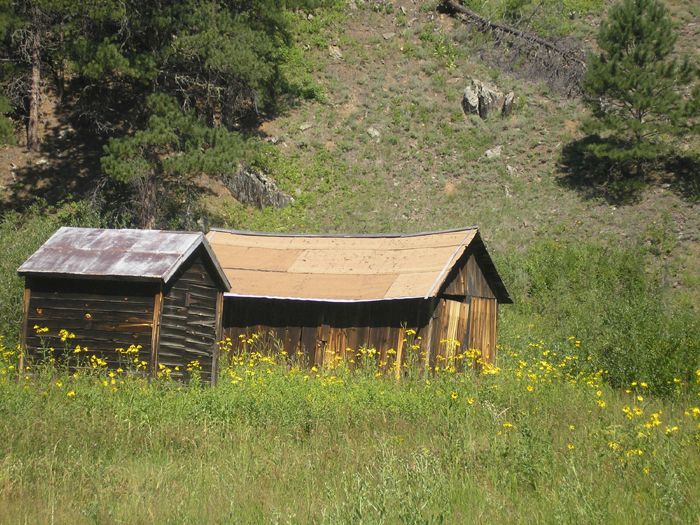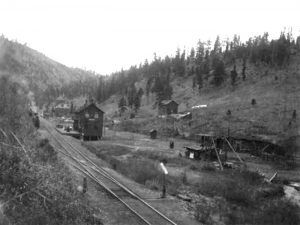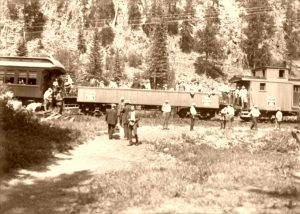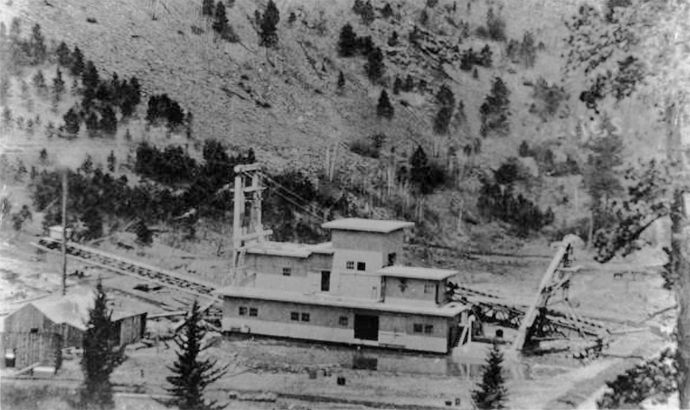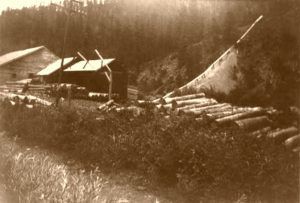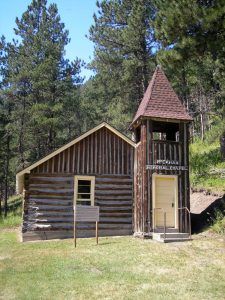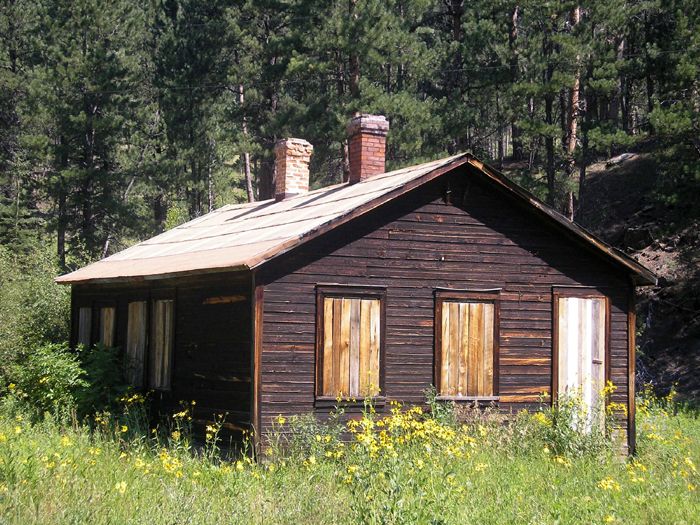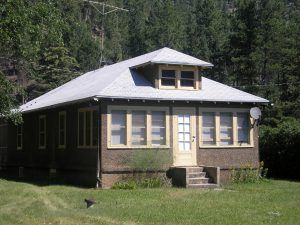The old mining camp and railroad town of Mystic, South Dakota, is located along Castle Creek in Pennington County.
In 1874 George Armstrong Custer’s 1,000-man Black Hills Expedition explored the valley where Mystic would later be settled. The following year, geologists found gold on Castle Creek, which started the Black Hills Gold Rush. In 1876, a small mining camp was established on Castle Creek that was first called “Sitting Bull.” By 1879, it was home to about 100 people but never grew larger as miners soon spread out to more prosperous mining claims, especially those farther north at Deadwood and Lead. By then, the Black Hills were bustling with mills, shafts, sluices, flumes, cyanide pits, and assay houses.
Placer mining kept the Sitting Bull camp in business, and in 1885, when a post office was established, the town’s name was changed to Mystic, probably after the town of Mystic, Connecticut.
In 1889, the Chicago, Burlington & Quincy Railroad, the first line into the Black Hills, was built through the area, and a station was established at Mystic. The railroad’s arrival spurred further mining activity, and by 1895, Mystic supported a ten-stamp mill. One of the most successful mines in the area was the Fairview Mine, located about a mile from the townsite.
In 1900, Rapid City businessman James Hartgering and investors from Chicago, Illinois, planned to build a reduction mill in Mystic, pouring about $1 million into the project. The four-story Mystic Reduction Mill was built beside the railroad tracks, utilizing a state-of-the-art electro-cyanide process. The crushed ore settled and solidified in the tanks when it was put to work for a trial. But, the investors were determined to show that the process had shown promise in other parts of the country and shipped more machinery to renovate the mill. By 1901, the mill could process 150 tons of ore each day. Many support buildings were constructed to support the large workforce needed to run the mill.
In 1906, Mystic received a second railroad when the town became the western terminal of the Rapid City, Black Hills, and Western Railroad. Better known as the Crouch Line, the 34-mile route from Rapid City traveled steep grades, made 14 complete circles, and crossed 100 bridges before arriving in Mystic. Mystic was soon busy transporting coal from Wyoming and timber and gold ore out of the Black Hills. Though a flood washed out all but five bridges in 1907, they were soon replaced, and the railroad line operated again.
In 1909, the first electric placer-mining dredge in the Black Hills was utilized in Mystic. The 78 buckets on the dredge worked continuously to dig up the gravel creek, moving some 55,000 yards of earth monthly. However, this operation soon proved too costly, and after just a few months, the dredge was dismantled and shipped to Oregon.
Though the mill was said to be 95% efficient during its operation, it didn’t regularly operate. It charged about $6 per ton, with a 75¢ freight charge. Though the reason for its irregular operation remains unknown, administrators blamed customers, who said they could not transport large amounts of ore to the mill. At the same time, though, there were reports of several management changes as they tried to make the mill successful. Ultimately, the mill was shut down, and the equipment was moved to Glendall, near Keystone, South Dakota. The mill was demolished in 1913.
In 1918 the entrepreneurial Sanford brothers built a sawmill on the old foundations of the Mystic Reduction Mill. Just a year later, the sawmill was purchased by George Frink, who would operate it for the next 33 years. In the early years, horses were used to pull the logs from their point of origin to his sawmill, and the finished products were shipped on the railroad. Once the automobile and larger trucks were manufactured, the logs and finished products were usually shipped by truck. Over the subsequent years, the sawmill became the economic mainstay for the town as mining declined.
The automobile also increased travel to the Black Hills, and the tourist industry flourished in the 1920s. As a result, George Frink built several cabins for the many people passing through the area. During this time, even President Calvin Coolidge and his wife Grace passed through the town when they arrived by railroad to visit a friend who had a cabin nearby in 1927.
In 1930, the McCahan Memorial Chapel was built by the Presbyterian Church and named for a woman from Philadelphia, Pennsylvania, who provided the funds. Frink’s Sawmill and the community’s men supplied the building materials and labor. Regular services were held until 1952. The building is sometimes still used for weddings and other religious events.
Frink’s Sawmill continued to operate through the Great Depression and, as he owned a store in town, allowed his employees to purchase supplies that could be deducted from their pay and worked out bartering systems with the loggers, who didn’t work full-time. Frink also had other issues to overcome during these years, as floods often destroyed parts of the railroad tracks and lumber stored at the sawmill. Another blow came when the sawmill was destroyed by fire in 1936, but again, Frink persevered and rebuilt the mill.
However, Mystic steadily declined after World War II due to the dwindling of timber and the need for coal. The Crouch Line ceased operations to Mystic, with the last passenger train departing in July 1947.
A few years later, George Frink closed the sawmill in 1952 and sold the equipment, marking the end of Mystic as a flourishing community. Afterward, the sawmill building was torn down. The post office closed in 1954.
Though the businesses and most people were gone, the Chicago, Burlington & Quincy Railroad continued to carry freight through the area until 1983. Afterward, the tracks were removed.
The Mystic Townsite District was named to the National Register of Historic Places in 1986. It includes 14 buildings, including a granary, boardinghouse, office, tourist cabins, sheds, and chapel.
Today, the town sits on the Black Hills National Forest land, just off graded Forest Service Road 231. Here begins the Mickelson Trail, a popular hiking trail along the old railroad route that is a popular trek with fantastic views.
Mystic is located off a gravel road 12 miles north of Hill City. The gravel road also leads to Rochford, another popular mining camp, just 7.5 miles to the northwest. The trip to Rochford is well worth the time, as it has even more historic buildings to accompany its history.
©Kathy Alexander/Legends of America, updated April 2023.
Also See:
Rochford – Friendliest Ghost Town in the Black Hills
South Dakota Ghost Towns & Mining Camps
South Dakota Ghost Town Photo Gallery
Sources:
Black Hills Pioneer
History.net
Mystic Interpretive Signs
Powder House Lodge
South Dakota Digital Archives

